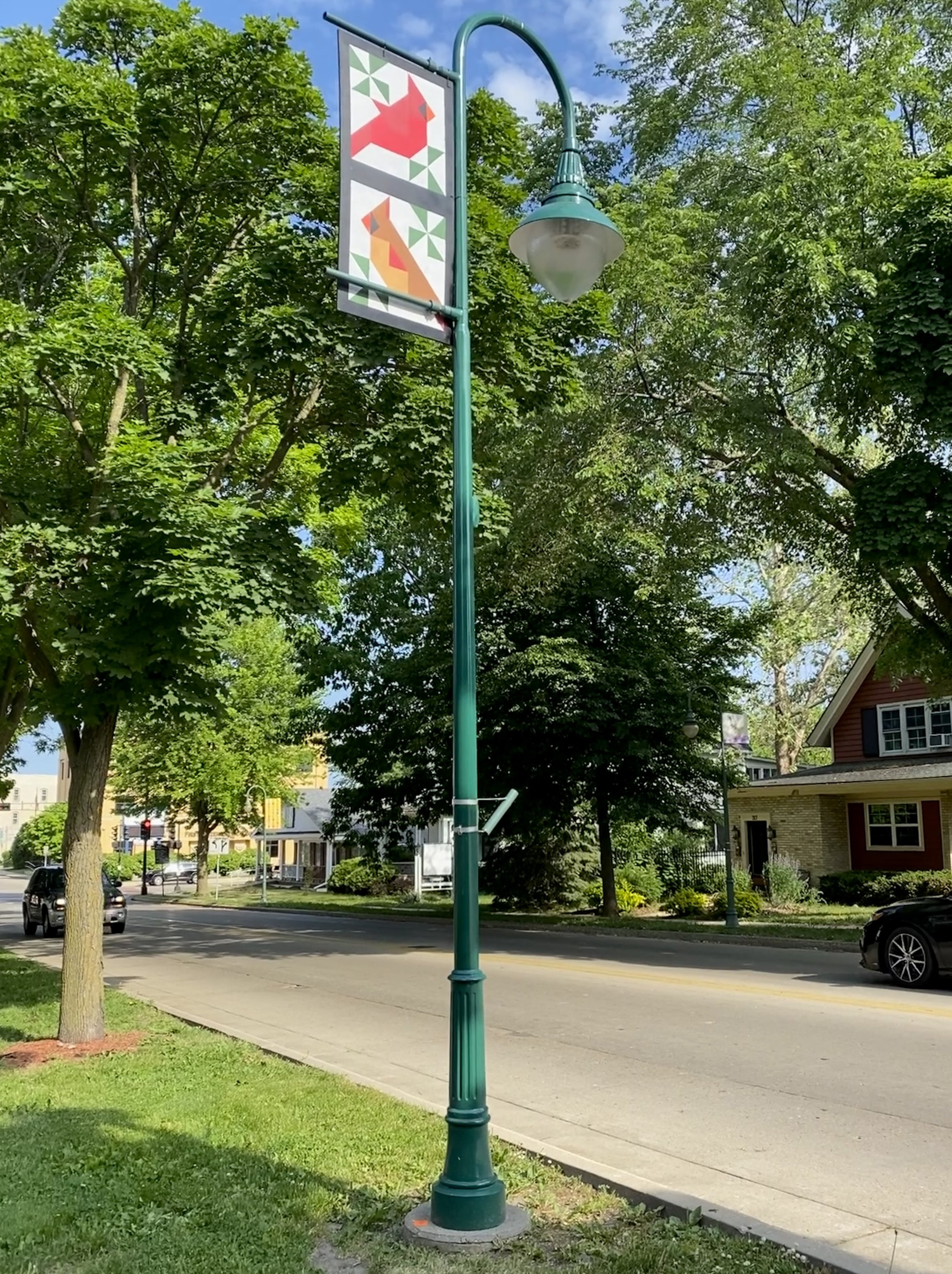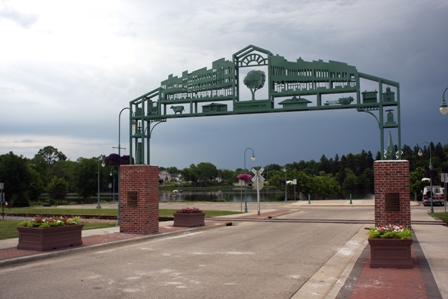Public Art Project 2023
Barn Quilts
The Whitewater Arts Alliance (WAA) and Whitewater Chamber of Commerce are excited to announce the exhibition of the Public Art Project for 2023 - “Barn Quilts.” This community-driven project–which enhances the beauty and cultural richness of Whitewater–is on display downtown from now until late September. Plywood boards that have been turned into “quilts” are hanging from light poles along Main Street. Some are 2’ x 4’ while others are 2’ x 2’. These projects will hang throughout the summer.
Participants in this year’s project are:
Jill Gerber
Riley Buckett
Donn Lahaie
Linda Saumer
Carol Haas
Tricia Borchardt
Sherry Stanek
Collin Anderson
Chris Blyth
D. Cahaie
Jeanine Fassl
Rick Fassl
Regan Hammons
Mila Holcombe
Nathan Kehoe
Ben Kelly
Stuart Nagy
Sharon Nordskov
Ryan Nordskov
Heidi Sherman
Rosa Spellman
Discover Whitewater
Studio 84
Culvers
Angela Anderson
AJ Borah
Hannah Brock
Michelle Dujardin
Candace Jacobs
Sean Jacobs
Sandy MacDonald
Lynn Weilbrenner
Ellen Penwell
Jennifer French
Michael Joers
Nicole Holder
Brin Martin
Charlie McGuire
Shannon McGuire
Sheryl Rosa
Ryan Rouse
Peggy Strong
And all other participants who wished to remain anonymous.
(specific photos, titles, and inspirations coming soon.)
The WAA believes that the public art plays a significant role in transforming the cultural fabric of a town. It brings people together, fosters dialogue and reflection, and creates a sense of pride and ownership among community members.
General Timetable
Sunday, February 26 - April 30: Call for Participation, can buy and pickup boards
UPDATE: final drop off on May 21 to either the CAC or Chamber. If date extension is needed, please contact either Ashe or Mary.
Thursday, June 1: Boards go up on lampposts downtown
Thursday, June 1 - end of September: Boards on display downtown
End of Summer (roughly September 30): Boards will come down and be taken to CAC
If there are any questions or concerns, participants and viewers may reach out to Mary Nevicosi (marynevicosi@yahoo.com), the chair of the project. Emails may also be sent to the WAA (wwartsalliance@gmail.com).
Check out Jefferson County’s Barn Quilt Tour: https://enjoyjeffersoncounty.com/barn-quilt-tour/
FAQs
Where can viewers see the boards?
You can find the boards hung up on lamp posts along Main Street of downtown Whitewater. They can be found on both sides of the street. They start from roughly the Cultural Arts Center and go all the way up to the intersection lights by the Brass Rail.Where are the projects due on May 21?
You can turn your boards either to the Chamber or the CAC during their regular open hours on this date. Boards will be coming up May 22, so this is the only day that they can be collected. You are welcome to turn your boards in early to either location.
Did the project deadline get extended?
Yes, the projects are now due May 21 to either the Chamber or the CAC.
How will the completed 2' x 4' boards be hung--portrait or landscape?
The boards will be hung portrait-style. So keep your 2’ extra space in mind to be either on the top or bottom of your barn square.Are we allowed to cut the boards in half to make them squares?
Of course! If you’d like to cut the boards to make them squares and remove the 2’ for dedication/honors/signature, you are more than welcome. Just be sure you sign it somewhere so we know who made the lovely piece!
How many artists/participants can work on a single board?
A single board can be purchased for $10 in person or $12 online, but the number of artists is unlimited. A business can have several employees work on a single board, or several artists can come together to complete their square. Money is only taken to pay for the boards themselves. We highly encourage camaraderie.
If you continue to scroll down, feel free to browse information about historical public art pieces around the City of Whitewater such as the Birge Fountain, The Prairie Tiller Mural, and the Cravath Lake Archway.
The Birge Fountain
The Birge Fountain was donated to the City of Whitewater in 1903 by Julius Birge who in 1839 had become the first child born to European settlers in Walworth County. The fountain was made by the J.W. Fiske Company of New York and consisted of a cast iron base and five figures made of zinc and painted to look like bronze. In 1983 the theft of one of cherubs and dolphins prompted a refurbishment which resulted in the recasting in
bronze of the four cherubs on dolphins by UW-Whitewater Professor James Wenkle. The "lost wax" technique was used and four new bronze pieces were then painted white to match the remainder of the statue. The fountain was vandalized in 1998 leading to the eventual recasting of the Maid of the Mist in bronze by Fort Atkinson artist Jerry Sawyer. In 2001 the five bronze figures were reinstalled and the remaining parts of the fountain were painted in bronze tones to match and regain the original appearance of 100 years ago. A trust fund was also established to provide for the fountain's future needs.
Prairie Tillers Mural
In 1980, Caryl Yasko created a tribute to the Kettle Moraine. The elements of the mural celebrate the courage and perseverance of our city founders while respecting our unique Kettle Moraine geography with its rolling hills and prairies, and the native Americans who held this land sacred for centuries.
The figures on the right side of the mural depict three time periods in history: the tribal era, the early settlers and the people of the present - us - working hard to make history by turning the water wheel to extract the power to build a dream. The figures on the left represent future generations who will take and use what we have to continue the dream. These figures are unformed and undefined to remind us that the future can be shaped by us, by the decisions and choices we make today.
The large circle in the center of the composition represents a millwheel. Early Whitewater settlers depended on water power to mill lumber, paper and grain. The first such mill, built by Dr. Trippe in 1839, was in continual use until 1963 and eventually razed in 1972. The wheel is painted with decorative symbols of Whitewater's accomplishments in agriculture, education, tourism, retail business, manufacturing and milling. The Territorial Oak which still stands at the intersection of Franklin and Main, forms the center of the waterwheel. That great old Burr Oak is the tree from which Whitewater was originally surveyed.
Other elements symbolize the land on which this town was built, the waving prairie from delicate spring to flaming autumn. Prairie violet, shooting stars, pasque flowers, blue lupine, prairie smoke, yellow coneflowers and prairie dock are some of the flowers depicted. The blazing colors of autumn merge into the flames of the annual prairie burnings and the historic fires of Whitewater.
If we took a giant cake knife and sliced a hill of the Kettle Moraine, what might we see? The hand-molded sculpture at the base of the mural sits on a limestone bedrock wall and represents the hills and kettles shaped by the glaciers. The rusted iron machine parts, which are integrated into the concrete relief, symbolize the hard work of the farmers to tame the wild prairie and establish an agricultural area. Members of the community brought metal treasures from their yards and farms to embed in the sculpture. Potawatomi and Winnebago fabric designs influence other portions of the sculptural relief.
When first painted in 1980, Prairie Tillers celebrated the spirit of Whitewater. In return, the mural was celebrated throughout the world. Artists and writers came to Whitewater to photograph and write about the mural and to publish its story in books. People can read about Prairie Tillers in the libraries of our cities. The mural tells the Whitewater story. It was designed with the unique ideas and the history of the people in this town and can exist nowhere else. Unfortunately, by 1989, the mural was lost due to unexpected problems with the brick wall. The loss was deeply regretted by the community and immediately citizens began to dream of bringing it back.
With the resurfacing and repainting project of 2004, once again the mural stands ready to greet visitors from around the world and share with them the memories of the past and the hopes for the future.
Cravath Lake Arch
The sculpture depicts two cityscapes and fourteen three-dimensional models of places and things important in the history of Whitewater. The models, their significance and the sponsor of each model are identified in plaques at the base of the arch. The arch is made of steel and was fabricated by Charles Scharine of the Scharine Group working from Lueck's sculptures. The arch was a community project with community donated funding and materials and was erected in 2008.







